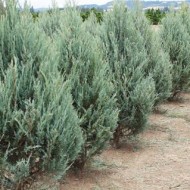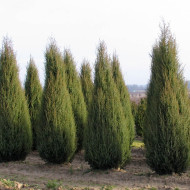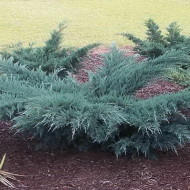Difficulties of growing juniper virginiana in the open field
Content
Description of virginian juniper
The homeland of the evergreen long-lived plant is North America. There it can be found in rocky or swampy areas. A highly branched powerful root system allows the shrub to not be afraid of strong winds, and also to stay on steep slopes.
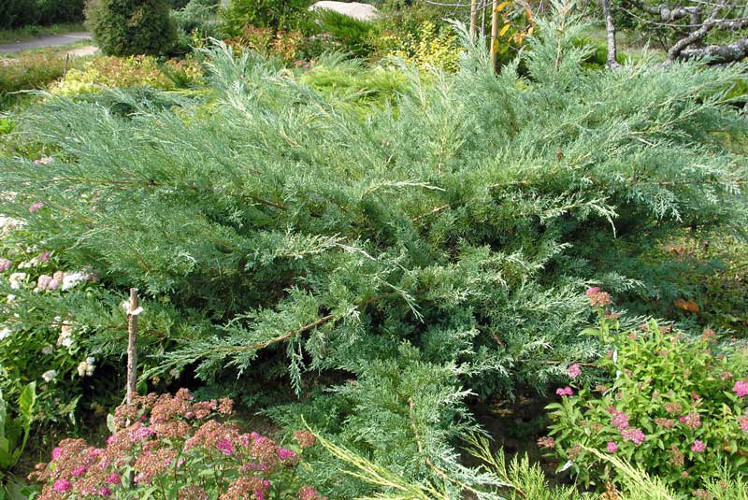
Juniper virginiana (Juniperus virginiana) is a monoecious coniferous culture of the Cypress family. Depending on the variety, it has a vertical or creeping trunk, covered with dense bark. The crown shape can be conical or funnel-shaped. The height also varies, but does not exceed 30 m. The needles are green-gray, sometimes with a blue tint, scaly, very small. The fruits are small dark blue cones with a waxy coating that stick to the branches until the first frost.
Video "Types and varieties of juniper"
In this video, experts talk about popular types and varieties of coniferous crops.
Popular varieties in horticulture
Today, botanists know about seven dozen varieties of the Virginia juniper. Some of them are successfully grown in central Russia. We will give a description of the most popular varieties below.
Hetz
Juniperus virginiana Hetz is a short shrub with a spreading, funnel-shaped crown, no more than a meter in height. The needles are gray-blue, by autumn they acquire a red-brown tint. The berries are dark blue with a waxy bloom. Hetz feels comfortable in well-lit areas, loves loams enriched with limestone or sand. Requires shelter for the winter.
Glauca
Medium-sized juniper with a conical crown. Differs in high growth rates - up to 20 cm annually. The branches are strong, erect, but become brittle with age. The needles are needle-like, rather small (1-2 mm). The color palette consists of blue and green shades, which acquire a bronze tint closer to autumn. Glauka loves the sun, and is also not capricious at all.
Gray Оwl
A low-growing, spreading plant with creeping branches. It grows up to 1.5-2 m with an annual growth of 5-10 cm. The green part is scaly, casts a bluish-gray tint. Cones are light blue with a grayish bloom. Gray Oul feels comfortable on moist, well-drained soil. He loves space, and therefore the distance between the bushes should be at least one and a half meters.
Moonglow
Virginia juniper of medium height with a conical crown. Its dimensions reach 4 m in height and 1.5 m in breadth. The seasonal growth is about 15 cm. The needles are dark green, with a bluish-gray tint, very small. Fruits are cone-shaped, blue-black with a waxy coating. Loves good lighting, picky about growing conditions, frost-resistant.
- Moonglow
- Glauca
- Hetz
- Gray owl
The advantages and disadvantages of culture
Like all plants cultivated by humans, the coniferous shrub has two sides of the coin.
- high decorative qualities;
- minimum care requirements;
- good tolerance to low temperatures and arid conditions;
- air saturation with pure oxygen;
- benefits to the body;
- wide application in landscape design.
- with a lack of sunlight, decorativeness decreases;
- rots quickly on excessively moist soil.
Agrotechnics of growing virginian juniper
In order for a young plant to successfully adapt to new conditions and develop normally, it will be useful to study the main agrotechnical rules before planting.
Site and soil selection
Coniferous crops are best planted in spacious areas with an abundance of sunlight. The shrub is undemanding to the ground and can grow even on depleted soils. However, well-drained, enriched loams or sandy loams are best suited for it.
Selection and preparation of seedlings
Youngsters for planting must be strong and healthy. It is better if the seedling before this will grow in a container - so it is more convenient to transplant it to a permanent place by transshipment. Juniper with an open root system, however, requires more attention. First, you need to carefully examine the rhizome for damage. Secondly, such bushes can be planted only in May or October, creating comfortable conditions for them to adapt.
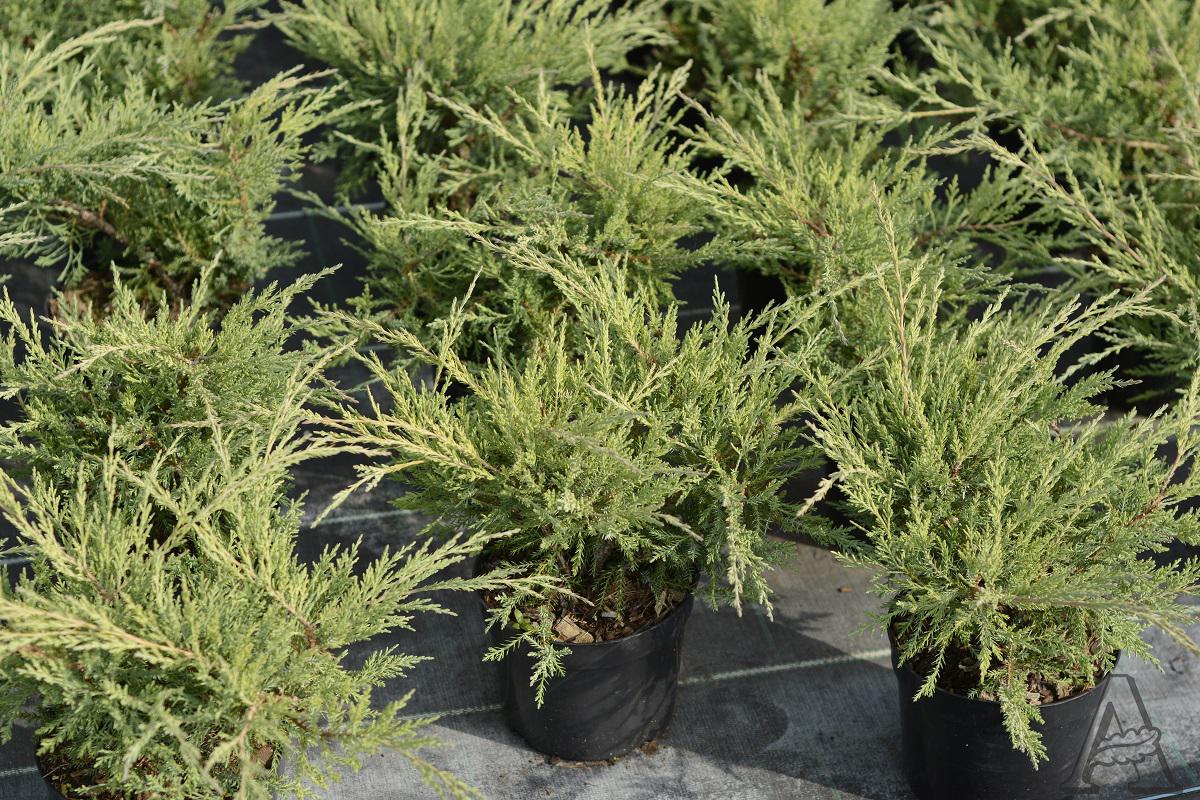
Planting recommendations
The place on the site is prepared in advance, digging holes 60x80 cm in size with an interval of 1-1.5 m from each other. At the same time, a substrate is prepared, consisting of sod land, peat, sand and humus. Having placed the seedling in the hole, it is quickly covered with soil mixture, preventing the rhizome from weathering. Next, a bucket of water is poured under the bush, and the trunk circle is mulched with needles or sawdust.
Reproduction methods
Like all shrubs, Virginia juniper reproduces in several ways:
- Cuttings. They are harvested in the spring, cutting off 5-7 cm from young branches. At the same time, two internodes and a "heel" (a piece of bark from a donor shoot) should be present on each process. Places of cuts are treated with "Kornevin", and then deepened into the substrate by two fingers. The cuttings are covered with a jar, creating a greenhouse environment, and germinated until roots are formed. Then the seedling is grown for a couple of years before being transplanted to a permanent place.
- Seeds. First, the planting material is hardened. To do this, it is sown in containers, which are then exposed to the cold, keeping under a snow cap for 4-5 months. In late spring, they are transplanted to a garden bed, deepening by 2-3 cm.The surface is covered with mulch, regularly moistened and gently loosened. The first 14 days of seedlings provide partial shade. In open ground, seedlings are planted when they reach the age of three.
Also, coniferous crops can be propagated by layering or grafting. However, both of these methods are not very popular among gardeners.
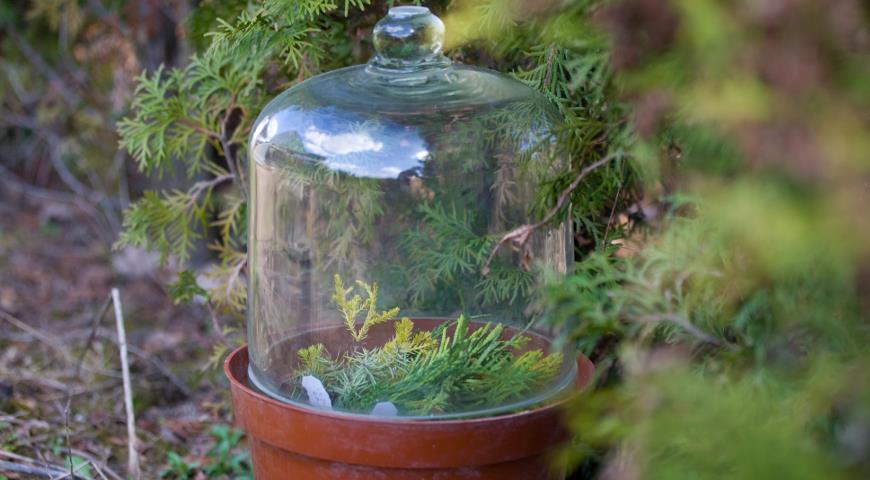
Plant care
The first years after transplanting, the juniper must be regularly moistened. Older bushes are watered only with a prolonged absence of rain, no more than 3 times a month. In extreme heat in the morning or after sunset, spraying can be done occasionally.
The plant is fed once (in the second half of spring). To do this, 30 g of nitroammofoska are introduced into the near-trunk circle.
Only hedge shrubs are subject to formative pruning. But it is imperative to remove dried branches and periodically thin out the crown for everyone.

Protection against diseases and pests
Most often, the coniferous culture suffers from necrosis or alternaria.The first sign is the formation of nodules on the aerial part of the plant. The bark dries quickly and cracks, exposing bare wood. If the disease is started, needles begin to fall off. To save the juniper, the affected shoots are cut off, and the cut sites are treated with garden pitch. The shrub itself is sprayed with a solution of copper sulfate (1%).
Due to the high content of aromatic essential oils, the plant is rarely affected by insects.
If it is nevertheless attacked by aphids, spider mites or thyroid glands, it is enough to treat the bush with insecticides such as "Aktara" or "Fitoverm".
It is not difficult to grow a virgin juniper on your site. The key to success lies in planting strong, healthy seedlings and adhering to all agrotechnical rules.

